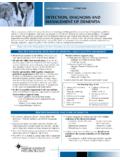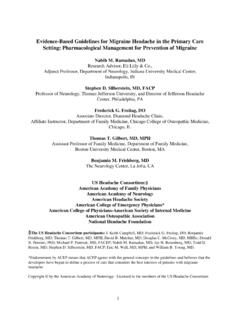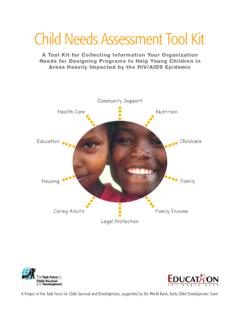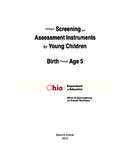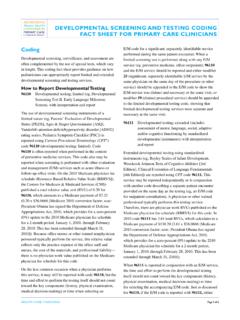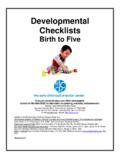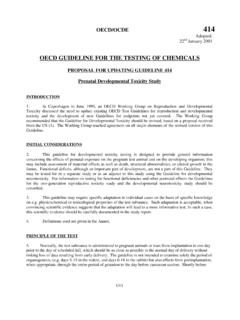Transcription of EVALUATION OF THE CHILD WITH GLOBAL …
1 AAN Guideline Summary forCLINICIANSEVALUATION OF THE CHILD WITHGLOBAL developmental DELAYM etabolic screening(serum amino acids; urine organic acids, acylcarnitines, mucopoly-saccharides;serum glucose, bicarbonate, lactate, pyruvate, ammonia,creatine kinase) Routine metabolic screening for inborn errors of metabolism is not indicated in the initial EVALUATION of a CHILD with globaldevelopmental delay , provided universal newborn screening wasperformedand the results are available for review. If newborn screening was not performed, if it is uncertain whethera patient had testing, or if the results are unavailable, metabolicscreening should be obtained in a CHILD with GLOBAL developmentaldelay.
2 Metabolic testing may be pursued in the context of historical or physical examination findings that are suggestive of a specific etiology (Level B*; Class II and III** evidence).Cytogenetic testing Routine cytogenetic testing is indicated in the EVALUATION of thechild with developmental delay even in the absence of dysmorphicfeatures or clinical features suggestive of a specificsyndrome (LevelB; Class II and III evidence).Fragile X Testing Testing for the Fragile X mutation, particularly in the presence of a family history of developmental delay , may be consideredin the EVALUATION of the CHILD with GLOBAL developmental preselection may narrow the focus of who should betested without sacrificing diagnostic yield.
3 Although screening for Fragile X is more commonly done in malesbecause of the higher incidence and greater severity,females are frequently affected and may also be considered for testing (Level B; Class II and Class III evidence).Rett syndrome testing The diagnosis of Rett syndrome should be considered infemaleswith unexplained moderate to severe mental retardation. If clinicallyindicated, testing for the MECP2gene deletion may be evidence exists to recommend testing of females withmilderclinical phenotypes or maleswith moderate or severedevelopmental delay (Level B; Class II and Class III evidence).
4 This is a summary of the American Academy of Neurology (AAN) and CHILD Neurology Society (CNS) guideline on diagnosis of thechild with GLOBAL developmental delay . GLOBAL developmental delay is a subset of developmental disabilities defined as significantdelay in two or more of the following developmental domains: gross/fine motor, speech/language, cognition, social/personal, andactivities of daily living. Those deficits are evident in comparison with the skills attainment of chronological peers. Significant delay isdefined as performance two standard deviations or more below the mean on age-appropriate, standardized norm-referenced testing.
5 This practice parameter reviewed available evidence concerning the value of diagnostic testing in the initial EVALUATION of a youngchild with a GLOBAL developmental delay that is static, nonprogressive, and has no clear etiology. Based on this evidence, below arespecific recommendations for each testing techniques In children with unexplained moderate or severe develop-mental delay , additional testing using newer moleculartechniques ( FISH, microsatellite markers) to assess for subtelomeric chromosomal rearrangements may beconsidered (Level B; Class II and Class III evidence).
6 Lead screening Screening of children with developmental delay for leadtoxicity may be targeted to those with known identifiablerisk factors for excessive environmental lead exposure as perestablished current guidelines (Level B; Class II evidence).Thyroid screening In the setting of existing newborn screening programs for congenital hypothyroidism, screening of children withdevelopmental delay with thyroid function studies is notindicatedunless there are systemic features suggestive of thyroid dysfunction (Level B; Class II evidence).
7 EEG An EEG can be obtained when a CHILD with GLOBAL developmental delay has a history or examination features suggesting the presence of epilepsy or a specific epilepticsyndrome (Level C; Class III and IV evidence). Data are insufficient to permit making a recommendationregarding the role of EEG in a CHILD with GLOBAL develop-mental delay in whom there is no clinical evidence ofepilepsy (Level U; Class III and IV evidence). Neuroimaging Neuroimaging is recommended as part of the diagnosticevaluation of the CHILD with GLOBAL developmental delay (Level B; Class III evidence).
8 As the presence of physical findings ( , microcephaly,focal motor findings) increases the yield of making a specificneuroimaging diagnosis, physicians can more readily consider obtaining a scan in this population (Level C;Class III evidence). If available, MRI should be obtained in preference to CTscanning when a clinical decision has been made thatneuroimaging is indicated (Level C; Class III evidence).EVIDENCE FOR EVALUATIONS OF THE CHILD with GLOBAL developmental DELAYThis is an educational service of the American Academy of Neurology.
9 It is designed to provide members with evidence-based guideline recom-mendations to assist with decision-making in patient care. It is based on an assessment of current scientific and clinical information, and is notintended to exclude any reasonable alternative methodologies. The AAN recognizes that specific patient care decisions are the prerogative of thepatient and the physician caring for the patient, based on the circumstances involved. Physicians are encouraged to carefully review the full AANguidelines so they understand all recommendations associated with care of these of this summary and a companion patient version are available at through AAN MemberServices at (800) and vision testing Children with GLOBAL developmental delay may undergoappropriate vision and audiometric assessment at the time of their diagnosis (Level C; Class III evidence).
10 Vision assessment can include vision screening and a fullophthalmologic examination (visual acuity, extra-oculo-movements, fundoscopic) (Level C; Class III evidence).This guideline summary is evidence-based. The AAN uses the following definitions for the level of recommendation and classification of evidence.*Recommendation Level: Level refers to the strength of the practice recommendation based on the reviewed literature. Level A: Established aseffective, ineffective or harmful or as useful/predictive or not useful/predictive; Level B: Probably effective, ineffective or harmful or as useful/predictiveor not useful/predictive; Level C: Possibly effective, ineffective or harmful or as useful/predictive or not useful/predictive; Level U: Data inadequate or conflicting; treatment, test or predictor unproven.
